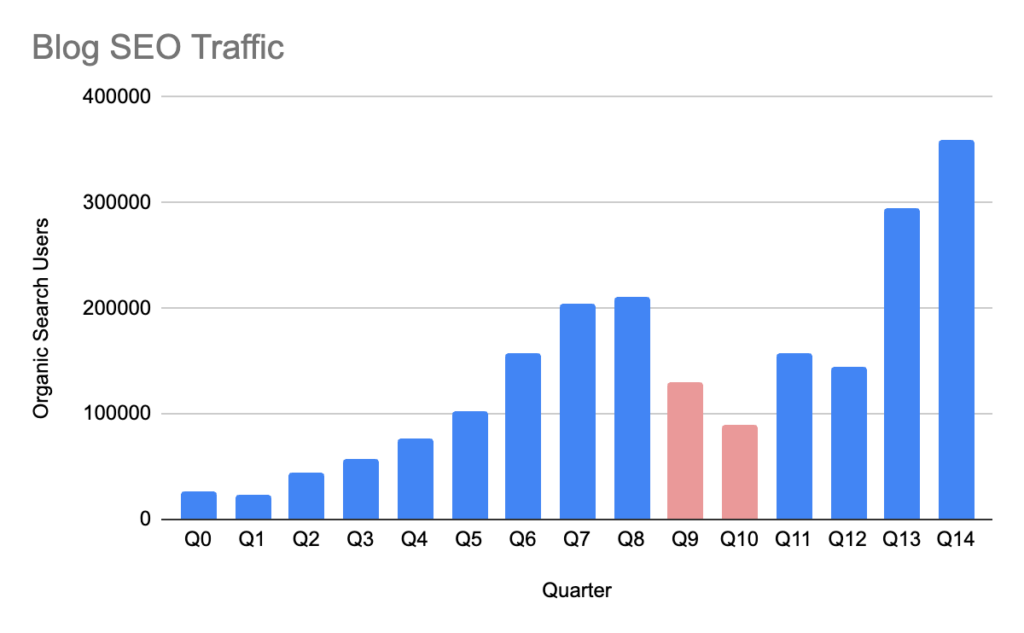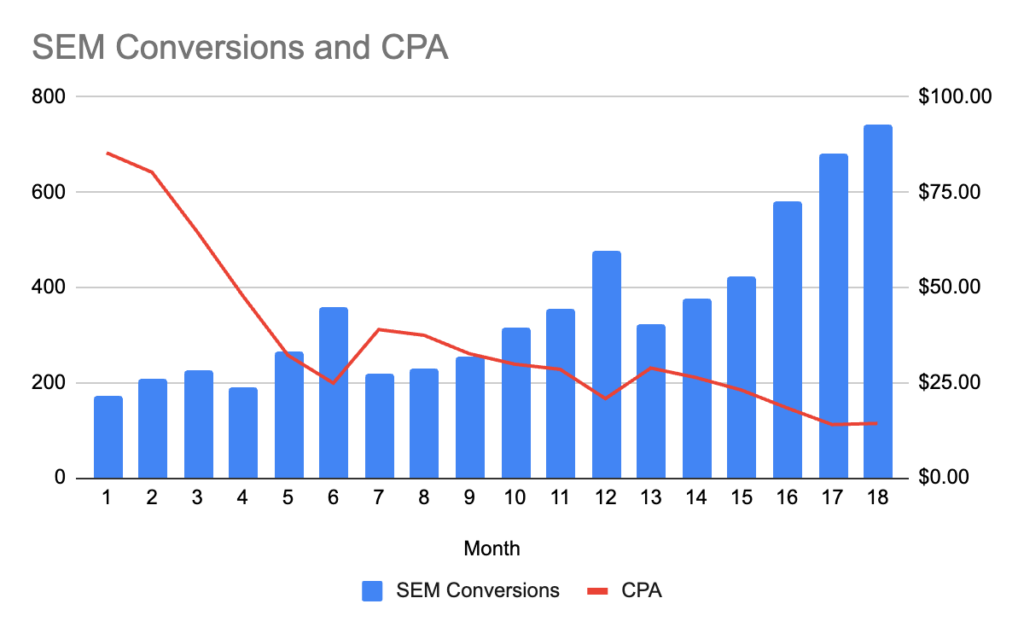Table of Contents
Pick a topic, draft a blog post, and publish. Check. See ya next week *closes laptop*.
Unfortunately, this is still the typical content development process for many businesses and marketing teams. Content is approached as if it's just another box to check on the way to SERP performance. We create and post, create and post, create and post, and then cross our fingers while waiting for results.
This transactional approach to content development is actually detrimental to search marketing efforts. If you want to see the best results, it's time to create content with purpose by taking a holistic approach.
The Dangers of the Transactional Approach
Have you ever seen Field of Dreams (if not, add it to your must-watch list)? In one scene, Ray, the beloved Iowa farmer, hears a voice say, "Build it and he will come" while taking a stroll through his cornfield.
Eventually, Ray listens to the voice and builds a baseball field on his land. And guess what? People came.

While I wish content worked this way—it doesn't. "Publish and they will come" isn't enough. Content is so much more than blog posts you quickly publish each week, month, or quarter. just for the sake of doing so.
This one-off, transactional approach to content creation doesn't support your overarching search marketing efforts. In fact, it hinders your progress. How?
Funnel Breakdowns
When developed mindfully, holistic content serves an incredible purpose: it moves your potential customers from awareness to conversion. However, content created using a transactional approach may not be properly mapped to the stages of your funnel.
This makes it next to impossible to serve the right content to your potential customers at the right time. And without doing that, you risk missing your audience completely.
Content Inconsistencies
All search marketing channels must work together for the best results (more on this later). This means SEO and SEM must collaborate to create content that sends a consistent message to your audience.
Taking a fractured, transactional approach often results in inconsistencies across organic copy and paid copy. For example, blog posts may serve messages that don't align with the landing pages they link to. Or a landing page may frame a product differently than the ad they clicked on to get there.
The result is unnecessary friction for your audience. And friction is something you must avoid at all costs for search marketing success.
Subpar Content Quality
As a copywriter myself, I would be remiss if I didn't mention how a transactional approach can affect content quality.
First of all, I get it. I know that marketing is tough work. I know that many teams experience pressure from stakeholders when it comes to getting results. And I know how easy it is to fall into the "publish and done" mindset.
Creating quality content that delivers value to your audience takes time and effort. Skipping steps such as developing in-depth outlines or sourcing knowledgeable writers for the sake of moving faster isn't truly effective.
Instead, it results in subpar content that doesn't connect with your audience. And that surely won't move the search marketing needle.
Wasted Time, Cash & Effort
All of the above consequences result in wasted time and cash. And I bet, as a busy in-house marketing team or agency, these losses aren't something you can afford.
Create Content Mindfully: Take a Holistic Approach
Whew. After all of that, are you ready for some good news?
All of the above dangers can be completely avoided. How? By creating content mindfully through a holistic approach to search marketing.
That's a lot of jargon, isn't it? Let's break it down:
A holistic approach to search marketing means using SEO, SEM, and content together to reach your goals.
A holistic approach means:
- Putting a stop to "random acts of content" and instead creating content mindfully so it fits perfectly into your funnel and serves your search marketing goals.
- Eliminating the "beef" between SEO and SEM teams, so they can work together to create awesome things.
- Using all forms of organic and paid content, from ad copy to blog copy, to build a cohesive search strategy that gets results.
Case Study: CaringBridge
Sound a little "pie in the sky"? It's not! At Uproer, we've used this approach to search marketing strategy to get some incredible results for our clients.
CaringBridge, a non-profit organization, enables caregivers and patients to communicate with their loved ones simply using an online journal. Since the start, CaringBridge has been dedicated to building a supportive community online, providing inspiration through stories and advice delivered via their website.
Because of this, we developed a search strategy that began with SEO-focused content and expanded into paid media over time. Using both SEO and SEM, we collaborated to develop content-focused campaigns.
Because of these efforts, the results were astounding:
- +250% increase in paid search conversions
- +1,200% increase in SEO blog traffic
- +53% Y/Y increase in conversions across SEM and SEO

Plus, we did all of this while significantly lowering CPA.

CaringBridge is only one of the many success stories we can tell to highlight just how beneficial a holistic approach can be. For example, Branch Basics grew SEO and SEM revenue by 84% in just 12 months by combining SEO and SEM efforts.
Additional Incredible Benefits of a Holistic Approach
The benefits of trading your transactional approach for a holistic approach go beyond improved KPIs. In fact, a holistic approach results in:
- More value: Not all content works for search marketing, but all search marketing content works for other marketing channels. By creating content mindfully, it's easy to repurpose it for other channels, such as sales, social, and beyond. And this delivers much more bang for your content buck.
- Higher content quality: Creating content for a holistic search strategy requires you to consider your target audience's needs in each stage of the funnel. It also requires you to be mindful of each piece of content's effects on other tactics, such as paid. In other words, a holistic strategy requires you to think before you publish, which often results in higher-quality content.
- Better budgeting: It's no secret that SEO and SEM teams must often fight for their piece of the budget. However, in a holistic approach, shared goals between both teams make it easier to allocate funds appropriately. This ensures everyone has the resources they need to do what must be done to see results.
- Improved brand consistency: A holistic approach enables you to be consistent in your brand messaging across content, whether you're writing an ad or a landing page. You don't see Coca-Cola using blue in their branding, do you? Nope—it's too close to Pepsi. Consistency leads to recognition which inspires your audience to see value in your business.
Get Moving Toward a Holistic Approach to Content
Ready to start creating content that actually serves your search marketing goals? If so, there are a few critical steps you can take to get started.
#1. Know Your Goals (Marketing and Business)
Hear me out: The content you create should serve your marketing and business goals. As Dave, our Senior Manager of SEO & Operations said:
"By starting with business goals and working backward from there, we can map out a plan that gets us from where we are to where we want to be."
For example, perhaps one of your business goals is to increase annual revenue. A subsequent marketing goal could be to increase organic leads by 30% by the end of the year. Knowing those goals, what (and how much) content do you need to publish to reach them?
By aligning all forms of content to your goals, you stop publishing for the sake of doing so. Instead, each piece of content you create pushes you closer to your goals.
#2. Map Content to All Stages of Your Funnel
It's common for teams to focus on just publishing ads or posting blog posts. However, in a holistic strategy, we want to build a connection between all of the moving parts. You must map meaningful content to each stage of the marketing funnel, from awareness to conversion.
Why? There's no one way a potential customer enters your funnel. While some may click an ad, others will read a blog post or sign-up for your email newsletter. To meet and capture potential customers where they are, your content will need to be there too.
One proven tactic is to develop top-of-funnel (TOFU), middle-of-funnel (MOFU), and bottom-of-funnel content (BOFU):
- TOFU content that builds awareness could be in the form of paid ads or blog posts that answer a common customer question.
- MOFU content that supports customers in considering a product or service could be in the form of comparison blog posts or product reviews.
- BOFU content that supports customers in making a decision could be in the form of pricing pages, brand-specific blog posts, or even product demos.
Mapping content this way enables you to show up whenever and wherever your potential customers need you the most.
#3. Stop Viewing SEO & SEM as Separate Entities
As I mentioned earlier, the silent rivalry between SEO and SEM is all too common. In fact, in many businesses and agencies, SEO and SEM work separately, never coming together to strategize.
But here's the deal: A holistic search strategy requires SEO and SEM teams to work side by side to create content that converts. The critical insights gathered from SEO can inform SEM and vice versa.
While you may be able to get some results by using these channels separately, you can see even better results by using them together, including the wallpaper effect.
Start Creating Content With Purpose With Uproer
Taking a transactional approach to content can lead to subpar results. However, a holistic approach can ensure you're developing content that helps you reach your search marketing goals.
If you're ready to start creating content with purpose, reach out to Uproer. After all, holistic strategies are kind of our thing.

